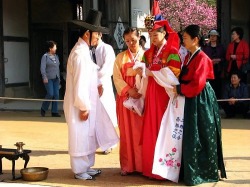Surviving On Their Own: What Determines And At What Age Does A Child Successfully Leave His Parents?
South Korea
Education
For a small number of people in South Korea, a child leaves home around age sixteen to go to secondary school, an age far below the average leaving age of 22 for women and 26 for men (4). Though this percentage may have gone up since the publishing of the source, it is evident that children in South Korea are, in some cases, leaving the home at younger ages than many other countries. Some of the more affluent people in Korea also send their children to schools outside of the country, such as the United States, to go to both secondary school and high school. These children are generally even more cut off from their family and parental home than the United States at university. Not only are they then leaving home at a younger age, they are also sometimes thousands of miles away. Because so much in South Korea relies on a good education, these forms of schooling can be preferable, regardless of the need to stay at the parental home.
Marriage

Traditional Korean Marriage
Marriage in South Korea is one of the main pathways to leaving the home. However, in some cases, whether or not the newlywed leaves the parental home can come into question. It is often decided before the wedding where the postnuptial couple will live – with the bride’s family, the groom’s family, or their own, separate living arrangements (6). Thus, leaving the home is encountered by either one or both parties upon marriage. In many cases, the couple decides to live apart from either family, on their own. However, living with the family is not completely uncommon. The average age that women leave home in South Korea is 22, while the average age for men is 26 (5). This is generally because women in South Korea marry younger than men, and so leave their homes sooner. Marriage is an important rite of passage throughout the world, and one of the major reasons to leave the parental home and start one’s own.
Initiation Ceremonies
South Korea, as a highly industrial and large society, does not have any predominant initiation ceremonies. However, within some of the subcultures of South Korea that may arise, there is a possibility of specific initiation ceremonies. Even though they are found throughout the world, there are specific themes that arise as the most important within initiation ceremonies. Because South Korea has been a predominately male dominated country, the focus in male ceremonies is primarily on responsibility, while for females it is focused more on fertility and sexuality (8). These teach the children specific roles and attitudes needed to adapt to adult life within their own societies and communities. However, though these attitudes still persist in the culture of South Korea, the initiation ceremonies themselves are harder to find, due to South Korea’s industrial society.
Cultural Variance
Though there is not as much cultural variance throughout South Korea as other countries, it still exists. They have less cultural variance than places such as the United States only because of their smaller size, and, in some part, high population density. There has also been a traditional Korean culture that has existed for generations, and many South Koreans take part in this culture. This traditionalist view can often be seen in marriage, as shown above. However, with increased globalization, their culture is changing and adapting. This leads to variance and change within the society, as new concepts and ideas are introduced and take hold. Within this post-industrial society, culture is still extremely important and varied, though perhaps not to the extent of other countries in the world.
Resources
4.) Yi, Zeng, Ansley Coale, Minja Kim Choe, Liang Zhiwu, and Liu Li. "Leaving the Parental Home: Census-based Estimates for China, Japan, South Korea, United States, France, and Sweden." Population Investigation Committee, Mar. 1994.JSTOR. Web. 30 Mar. 2010. <http://www.jstor.org/stable/2174959>.
5.) Ford, Kathleen, and Victoria Hosegood. "AIDS Mortality and the Mobility of Children in Kwazulu Natal, South Africa." Population Association of America, Nov. 2005. JSTOR. Web. 14 Apr. 2010. <http://www.jstor.org/stable/4147338>.
6.) Hirschman, Charles, and Ronald Rindfuss. "The Sequence and Timing of Family Formation Events in Asia." American Sociological Association, Oct. 1982. Web. 14 Apr. 2010. <http://www.jstor.org/stable/2095165>.
8.) Schlegel, Alice, and Herbert Barry, III. "The Evolutionary Significance of Adolescent Initiation Ceremonies." American Anthropological Association, Nov. 1980. JSTOR. Web. 15 Apr. 2010. <http://www.jstor.org/stable/643477>.
5.) Ford, Kathleen, and Victoria Hosegood. "AIDS Mortality and the Mobility of Children in Kwazulu Natal, South Africa." Population Association of America, Nov. 2005. JSTOR. Web. 14 Apr. 2010. <http://www.jstor.org/stable/4147338>.
6.) Hirschman, Charles, and Ronald Rindfuss. "The Sequence and Timing of Family Formation Events in Asia." American Sociological Association, Oct. 1982. Web. 14 Apr. 2010. <http://www.jstor.org/stable/2095165>.
8.) Schlegel, Alice, and Herbert Barry, III. "The Evolutionary Significance of Adolescent Initiation Ceremonies." American Anthropological Association, Nov. 1980. JSTOR. Web. 15 Apr. 2010. <http://www.jstor.org/stable/643477>.
